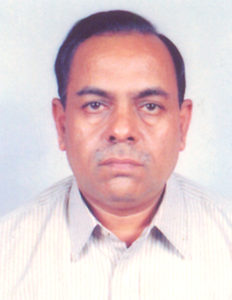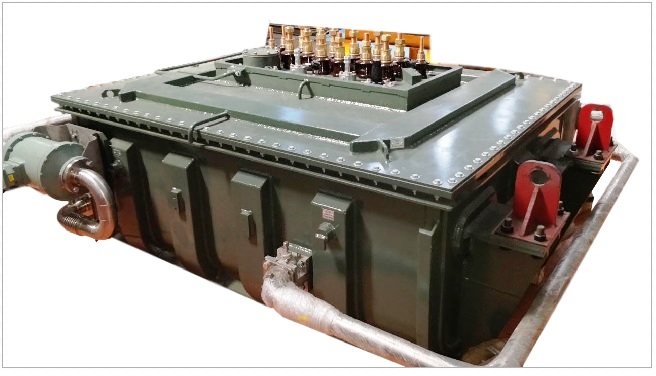
Indian Railways will soon be inducting dual-mode locomotives in its fleet. With this, trains will be able to run on both electric and diesel traction. Mumbai-based High Volt Electricals Pvt Ltd will be supplying dual-mode transformers that will be a key component of the propulsion system of these new-age locomotives. We have Rajesh V. Shah, CMD, High Volt Electricals Pvt Ltd, in this exclusive interaction with T&D India, giving keen insights on dual-mode transformers, and explaining how dual-mode locomotives can be a game-changer for the Indian Railways. An interview by Venugopal Pillai.
We understand that dual-mode transformers form part of dual-mode locomotives and can be used for both diesel and electric traction. What are the technicalities of dual-mode transformers?
Dual-mode transformers are used to step down the catenary voltage to be fed to convertors. This convertor will convert into DC then back to AC, to supply power to AC motors. Hence dual mode transformers are designed to suit this requirement like high impedance and are suitable for various harmonics generated by convertor. Being high impedance, the losses are more, resulting in higher cooling requirements and more regulation on the voltage front.
Secondly due to high harmonics of converter load and high impedance to the tune of 64 per cent, the transformer is housed in an aluminium tank so as to reduce the losses. This also helps in reduction of transformer weight.
Also, a part of the power generated by the diesel engine has to pass through the transformer as “hotel load”. This was achieved by better coupling impedance resulting in smooth operation during both modes. (In the context of railways, “hotel load” is the electrical load in the coaches for lighting, fans, air-conditioning, heating, pantry, etc.)
While designing, all these aspects need to be considered as the balance of above data is very vital to achieve a practical design and a workable transformer.
Indian Railways has targeted to electrify 40,000 rkm of track over the next 4-5 years. Despite this, do you see the demand for dual-mode transformers?
Yes, Indian Railways has a very ambitious project to electrify maximum route kilometers. However, the last-mile effort is always delayed due to various difficulties like arranging finances and resources. This could delay the overall project by 4-5 years. During this interim period, a dual-mode locomotive is a good solution. Secondly, once all the routes are electrified, these locomotives are going to work as electric locomotives and hence will not become redundant. In the future, we could have a solution to even upgrade these locomotives by removing the diesel engine and to upgrade them by using latest technology so as to increase the speed and haulage capacity, which right now constrained due to the sheer weight of the diesel engine and the diesel tank.
Normally all rolling stock is of the MTR (mid-term rehabilitation) variety where the period of renewal is 8-10 years. Hence, whatever was to be spent on MTR could go for upgrade of locomotives.
So the fear of what will happen to these dual-mode locomotives when all routes are electrified is unfounded. This is because dual-mode locomotives can continue to run in electric power mode, and when it is time for MTR, the same can be upgraded to suit the requirements at that time.
Has Indian Railways deployed dual-mode locomotives as yet in its network?
Dual-mode locomotives are in the final stage of production. The first one is expected to roll out from DLW Varanasi, in a month or two. [DLW or Diesel Locomotive Works is one of the production units of Indian Railways.]
Are there local suppliers of dual-mode propulsion systems, meant for DLW’s dual-mode locomotives?
At present the propulsion system is supplied by Hyderabad-based Medha Servo Drives Pvt Ltd. Medha’s technology is developed indigenously and the products are very price-competitive. Their design will be put to use in very short time. Our company, High-Volt Electricals, is a supplier of dual-mode transformers to Medha, and ultimately our transformers will form part of the dual-mode locomotives produced by DLW, Varanasi.
What about international suppliers of dual-mode locomotives?
Even globally, dual-mode locomotives represent a recent development in railway technology. As such, there are very few of such locomotives today.
At the “InnoTrans 2018” exhibition recently held in Berlin, two companies—Alstom and Siemens—displayed dual-mode locomotives. Alstom’s dual-mode locomotive was only for shunting purpose and these locomotives in fact had three modes—electric catenary, diesel and battery-operation. Those displayed by Siemens were of large capacity (6000 HP) and had two modes—electric and diesel.
Apart from your company High-Volt Electricals, which are the other Indian companies to make dual-mode transformers?
At present there is no other Indian manufacturer of dual-mode locomotive transformers. We are the first in India, at present. Our design was accepted by RDSO, DLW and Medha and we have supplied two dual-mode transformers Medha Servo Drives Pvt Ltd, out of the order for five numbers.
It has passed in all routine and type tests and currently the transformers are under commission on Indian Railways. The field performance test is awaited.
Is there export potential for dual-mode transformers?
There is definitely high potential to export dual-mode transformers. We look forward to venture into this business, once our parameters are approved in field trials.
What is your overall view on adoption of latest technology by Indian Railways?
In the railways business, India is in a position to adopt latest technology developed by say European, Japanese, Chinese or Korean companies. However, there is a difference in the way foreign technology is being absorbed. In the case of metro rail, there is definitely absorption of latest global technology. However, in the case of Indian Railways, there is a tendency to retain some old technology as it is not easy to discard old technology that is expected to have a life of 15-20 years. Further, existing technology will be required to run the present system. So, it becomes necessary to adopt new technology, step by step, so as to achieve maximum benefit from both technologies.
Till around 20 years ago, Indian Railways was not in a position to adopt the latest global technology. Now, technology adoption is better and the benefits of latest technology can be harnessed easily. In the metro rail business, technology adoption is better and that too without any investment by Indian Railways. Metro rail projects are developed by a quasi government body so the conventional rules of Indian Railways are done away with.
Now that High-Volt Electricals is a supplier of dual-mode transformers to the Indian Railways, how do you view business opportunities?
Business opportunities are very bright but we keep our fingers crossed till trial runs are done successfully!
Featured photograph shows the he dual-mode transformer designed and manufactured by High-Volt Electricals Pvt Ltd

